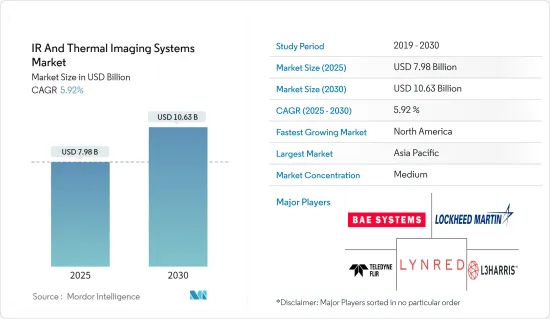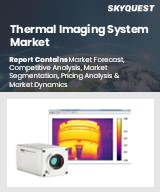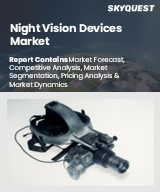
|
시장보고서
상품코드
1628711
적외선 및 열화상 시스템 : 시장 점유율 분석, 산업 동향 및 통계, 성장 예측(2025-2030년)IR And Thermal Imaging Systems - Market Share Analysis, Industry Trends & Statistics, Growth Forecasts (2025 - 2030) |
||||||
적외선 및 열화상 시스템 시장 규모는 2025년 79억 8,000만 달러로 추정되며, 예측 기간(2025-2030년) 동안 5.92%의 CAGR로 2030년에는 106억 3,000만 달러에 달할 것으로 예상됩니다.

적외선 및 열화상 이미징 기술은 완전한 어둠이나 어둡고 어두운 환경에서도 물체나 개인을 감지할 수 있습니다. 다른 방법과는 달리, 적외선 이미징은 주변 조명이 없는 환경에서도 작동할 수 있습니다. 적외선 열화상 카메라는 근적외선 조명과 마찬가지로 연기, 안개, 연무, 안개와 같은 차폐물을 투과할 수 있습니다.
주요 하이라이트
- 군사 및 국방 분야에서의 사용 증가로 인해 적외선(IR) 및 열화상 시스템에 대한 전 세계 수요가 증가하고 있습니다. 전 세계 군대는 상황 인식, 감시, 목표물 포착 및 야간 투시 능력을 강화하기 위해 적외선 열화상 카메라를 사용하고 있습니다.
- 군사 및 국방 연구 개발 프로그램에서 적외선(IR) 파장은 대부분의 감시 및 표적 포착이 야간에 이루어지기 때문에 적외선(IR) 파장에 우선순위를 두고 있습니다. 군은 주로 야간 투시경, 미사일 유도 시스템, 공중 전방 적외선(FLIR) 스캐너에 적외선 기술을 사용하고 있습니다. 군사 및 국방 분야에서 적외선 이미징 기술에 대한 수요가 증가함에 따라 시장 성장이 더욱 가속화되고 있습니다.
- 저렴한 가격대의 솔루션이 등장하면서 전 세계 열화상 카메라 시장에 큰 영향을 미쳤습니다. 과거에는 산업 및 군사 분야에서 사용되는 고가의 고가 장비가 주류를 이루었지만, 센서 기술의 발전, 대량 생산 및 소형화로 인한 비용 절감으로 인해 상황이 바뀌었습니다. 이러한 발전으로 적외선 이미징은 가전, 의료, 공공안전 등 다양한 산업 분야에서 활용되고 있습니다.
- 기술의 발전은 적외선 열화상 카메라의 효율성, 편의성, 범용성을 향상시켜 적외선 열화상 카메라의 보급을 촉진하고 있습니다. 센서의 고해상도화, 이미지 처리 능력 향상, 기기 소형화 등의 기술 혁신으로 다양한 산업 분야에서 정확도와 사용 편의성이 향상되고 있습니다. 이러한 발전은 더 나은 열 감지, 더 세밀한 이미지 처리, 더 작고 휴대 가능한 장비에 열화상 카메라를 통합할 수 있게 해줍니다.
- 열화상 카메라 및 적외선 시스템은 매우 전문적인 기술이며, 설치, 운영 및 유지보수는 전문가가 수행해야 합니다. 시스템 교정 및 유지보수 등 일상적인 지원 업무를 수행할 수 있는 전문 인력이 부족하여 운영의 비효율성을 초래하고 있습니다. 신속한 지원을 받지 못하면 열화상 카메라의 정확도와 신뢰성이 떨어지고 성능에 영향을 미칠 수 있습니다.
적외선 및 열화상 시스템 시장 동향
산업용이 큰 비중을 차지
- 산업 분야에서는 장비 및 공정의 유지보수, 검사, 모니터링에 적외선 및 열화상 기술을 활용하는 사례가 증가하고 있습니다. 제조, 에너지 및 건설 산업에서 열화상 이미징은 과열, 에너지 손실, 장비 고장과 같은 문제를 감지하여 비용이 많이 드는 수리 및 다운타임을 방지하고 있습니다. 이러한 추세에 따라 예지보전 및 품질 관리 분야에서 열화상 카메라에 대한 수요가 크게 증가하고 있습니다.
- UNECE에 따르면 2023년 알바니아의 건설 산업은 GDP 대비 유럽 최대 규모가 될 것입니다. 영국의 건설업은 GDP의 6.2%를 차지하며 이는 독일과 비슷한 수준입니다.
- 산업 분야의 확장에 박차를 가하는 주요 요인 중 하나는 예지보전 분야에서 적외선 열화상 카메라와 적외선 기술의 활용입니다. 열화상 이미징은 기계 및 장비의 핫스팟, 누수, 전기적 문제가 고장의 원인이 되기 전에 발견하는 데 자주 사용됩니다. 예지보전을 통해 기업은 예정된 다운타임을 줄이고 고가의 수리 비용을 절감할 수 있습니다.
- 열화상 이미징 시스템은 산업 품질 관리 및 공정 모니터링 애플리케이션에서 점점 더 중요해지고 있습니다. 제조 업계에서는 온도 변화에 민감한 공정을 모니터링하고, 결함을 식별하고, 제품의 균일성을 보장하기 위해 적외선 및 열화상 기술을 사용하고 있습니다. 이는 금속 및 폴리머 가공, 전자 제품 제조와 같이 정확한 온도 관리가 필수적인 분야에서 특히 중요합니다.
- 산업 분야에서 적외선 및 열화상 이미징의 또 다른 중요한 용도는 에너지 감사입니다. 기업들은 건물 에너지 감사를 위해 적외선 및 열화상 기술을 점점 더 많이 사용하고 있습니다. 이러한 감사는 단열 불량, 누수, 비효율적인 난방 시스템 등 에너지 손실을 발견하는 데 도움이 됩니다. 특히 시멘트, 철강, 화학 생산과 같은 중공업 분야에서 지속가능성과 에너지 효율에 대한 관심이 높아지면서 이러한 움직임이 가속화되고 있습니다.
아시아태평양, 큰 성장세를 기록
- InfiRay와 Hikmicro와 같은 중국 기업들은 판매량 중심 전략에 힘입어 지속적으로 성장하고 있으며, 그 결과 산업 시장과 소비자 시장 모두에서 영향력을 확대하고 있습니다. 중국의 열화상 이미징 부문은 전 세계 열화상 카메라 출하량의 상당 부분을 차지하는 중요한 이정표를 달성했습니다. 다양한 산업 분야에서 열화상 기술에 대한 수요가 증가하고 있으며, 이 지역의 시장 입지가 더욱 확대될 것으로 예상됩니다.
- 적외선 및 열화상 이미징 시스템은 산업 분야에서 큰 인기를 끌고 있습니다. 투자 확대와 생산성 향상으로 인해 이 지역의 산업 부문 전반에서 이 기술에 대한 수요가 증가할 것으로 예상됩니다. 세계경제포럼(World Economic Forum)에 따르면, 중국은 제조 역량을 강화하기 위한 노력을 강화하고 있으며, 이는 2024년 첫 7개월 동안 제조 부문의 기술 전환을 위한 투자가 10.9% 증가하여 두 자릿수 성장세를 유지하고 있는 것으로 나타났습니다.
- 기술의 발전으로 마이크로보로미터가 탄생했고, 예측 기간 동안 많은 성장이 예상됩니다. 팬데믹(세계적 대유행)으로 인해 일본에서는 운송, 제조, 공공안전 등 다양한 분야에서 열화상 카메라에 대한 수요가 증가하고 있습니다. 예를 들어, 일본을 포함한 아시아태평양의 공항에서는 적외선 열화상 카메라가 여행객을 감시하는 데 사용되고 있습니다. 이러한 큰 보급은 이 지역의 시장 성장을 촉진할 것으로 예상됩니다.
- 공항의 국내선 터미널 보안 게이트 앞에 적외선 열화상 카메라가 설치되어 항공사 직원이 평가를 실시하고 있습니다. 일본은 수도권에서 COVID-19의 전파를 완화하기 위한 노력의 일환으로 금요일 여러 공항에서 국내선 출발 승객에 대한 의무적인 체온 검사를 시작했습니다. 이 지역의 교통 부문에 적외선 영상 기술을 광범위하게 도입하면 이 시장의 잠재력이 높아질 것으로 예상됩니다.
적외선 및 열화상 시스템 시장의 경쟁 상황
적외선 및 열화상 이미징 시스템 시장은 Teledyne FLIR LLC, L3Harris Technologies Inc. 등의 기업들은 제품 혁신을 통해 시장 점유율을 확대하기 위해 노력하고 있습니다.
경쟁의 정도는 브랜드 아이덴티티, 강력한 경쟁 전략, 투명성 등 시장에 영향을 미치는 다양한 요인에 따라 달라집니다. 시장 구매자는 프로세스를 최적화하기 위해 보다 효율적인 솔루션을 추구하기 때문에 조사 대상 시장에서 혁신을 통한 지속적인 경쟁 우위는 높은 편입니다.
많은 R&D 투자, 장기 계약, 브랜드 아이덴티티로 인해 철수 장벽이 높아 기업이 쉽게 시장에서 철수하기 어려운 상황입니다. 제품 차별화, 인수합병, 전략적 제휴 등 경쟁 전략으로 인해 조사 대상 시장에서는 치열한 경쟁이 벌어지고 있습니다.
이 시장은 제품 기술력 향상을 위해 많은 투자를 해온 전통 있는 기업들로 구성되어 있습니다. Teledyne FLIR LLC, L-3 Communications, BAE Systems 등이 있습니다. 예를 들어, 2023년 10월 스카이디오(Skydio)는 Teledyne FLIR Boson 열화상 카메라 모듈을 탑재한 X10 UAV를 발표했습니다. 이 협력의 결과로 공공안전 및 중요 인프라 점검 전문 조종사들은 비냉각 적외선 열화상 카메라 기술을 쉽게 사용할 수 있게 되었습니다.
기타 혜택
- 엑셀 형식의 시장 예측(ME) 시트
- 3개월간의 애널리스트 지원
목차
제1장 소개
- 조사 가정과 시장 정의
- 조사 범위
제2장 조사 방법
제3장 주요 요약
제4장 시장 인사이트
- 시장 개요
- 업계의 매력 - Porter's Five Forces 분석
- 신규 참여업체의 위협
- 구매자/소비자의 협상력
- 공급 기업의 교섭력
- 대체품의 위협
- 경쟁 기업 간의 경쟁 관계
제5장 시장 역학
- 시장 성장 촉진요인
- 저비용 솔루션
- 업종을 넘나드는 용도 확대
- 환경에 대한 적은 영향
- 시장 과제
- 정기적인 서포트와 서비스의 결여
제6장 시장 세분화
- 솔루션별
- 하드웨어
- 소프트웨어
- 서비스
- 용도별
- 산업용
- 보안
- 연구개발
- 건설 산업
- 해양
- 운송
- 법집행기관
- 기타 용도
- 폼팩터별
- 핸드헬드 이미징 디바이스 및 시스템
- 고정형(회전식·비회전식)
- 지역별
- 북미
- 미국
- 캐나다
- 유럽
- 영국
- 독일
- 프랑스
- 아시아
- 중국
- 일본
- 인도
- 호주·뉴질랜드
- 라틴아메리카
- 브라질
- 멕시코
- 아르헨티나
- 중동 및 아프리카
- 사우디아라비아
- 아랍에미리트
- 남아프리카공화국
- 북미
제7장 경쟁 구도
- 기업 개요
- Teledyne FLIR LLC
- L3Harris Technologies Inc.
- Lynred
- Lockheed Martin
- BAE Systems PLC
- Leonardo DRS
- Elbit Systems Ltd
- RTX Corporation
- Sofradir Group
- Thermoteknix Systems Ltd
제8장 투자 분석
제9장 시장 기회와 향후 동향
ksm 25.01.17The IR And Thermal Imaging Systems Market size is estimated at USD 7.98 billion in 2025, and is expected to reach USD 10.63 billion by 2030, at a CAGR of 5.92% during the forecast period (2025-2030).

Infrared and thermal imaging technology enables users to detect objects or individuals in complete darkness and in difficult and distinct conditions. Unlike other methods, thermal imaging works in environments without any ambient light. Like near-infrared illumination, thermal imaging can penetrate obscurants like smoke, fog, and haze.
Key Highlights
- The global demand for infrared (IR) and thermal imaging is growing due to the increased use of these technologies in military and defense applications. Armed forces worldwide rely on IR and thermal imaging for enhanced situational awareness, surveillance, target acquisition, and night-vision capabilities.
- Military and defense R&D programs prioritize infrared (IR) wavelengths, given that many surveillance and targeting operations occur at night. The military primarily uses infrared technology in night vision goggles, missile guidance systems, and aerial forward-looking infrared (FLIR) scanners. The rising demand for IR imaging technology in the military and defense sectors is further accelerating the growth of the market.
- The emergence of affordable solutions had a considerable impact on the global market for infrared and thermal imaging systems. Previously dominated by high-end, costly equipment mostly utilized in the industrial and military sectors, the landscape changed because of cost reductions brought about by advances in sensor technology, mass production, and miniaturization. Due to these advancements, thermal imaging is used in several industries, including consumer electronics, healthcare, and public safety.
- Technological advancements are promoting the adoption of IR and thermal imaging systems by enhancing their efficiency, accessibility, and versatility. Innovations such as higher-resolution sensors, improved image processing capabilities, and the miniaturization of devices have increased their accuracy and usability across various industries. These advancements enable better heat detection, more detailed imaging, and the integration of thermal cameras into smaller and more portable devices.
- Thermal imaging and infrared systems are extremely specialized technologies that need to be installed, operated, and maintained by professionals. Operational inefficiencies are caused by a shortage of qualified personnel to perform routine support tasks, such as system calibration and maintenance. The accuracy and dependability of thermal imaging systems might deteriorate in the absence of prompt support, which can impact their performance.
IR & Thermal Imaging Systems Market Trends
Industrial Applications Hold Major Share
- Industrial sectors are increasingly utilizing thermal imaging to maintain, inspect, and monitor equipment and processes. In manufacturing, energy, and construction industries, thermal cameras detect issues like overheating, energy loss, and equipment malfunctions, preventing costly repairs and downtime. This trend drives significant demand for thermal imaging systems in predictive maintenance and quality control as companies aim to enhance efficiency and safety while reducing operational risks.
- According to UNECE, in 2023, Albania had the biggest construction industry relative to its GDP in Europe. The construction industry in the United Kingdom accounted for 6.2% of its GDP, which is equal to Germany's.
- One of the main factors fueling the expansion of the industrial segment is the use of thermal imaging and infrared technologies in predictive maintenance. Thermal cameras are frequently utilized to find hotspots, leaks, and electrical problems in machinery and equipment before they cause failure. By being proactive, companies may cut down on scheduled downtime and save money on expensive repairs.
- Thermal imaging systems are becoming more crucial in industrial quality control and process monitoring applications. Manufacturers use these systems to monitor temperature-sensitive processes, identify flaws, and guarantee product uniformity. This is especially important in sectors where exact temperature control is essential, like the processing of metals and polymers and the creation of electronic products.
- Another significant use of infrared and thermal imaging devices in the industrial sector is energy auditing. Businesses are using thermal cameras more often to do energy audits in their buildings. These audits help detect areas of energy loss, such as inadequate insulation, leaks, and inefficient heating systems. Growing concerns about sustainability and energy efficiency, especially in heavy industries like cement, steel, and chemical production, are the driving force behind this movement.
Asia-Pacific to Register Major Growth
- Several Chinese firms, such as InfiRay and Hikmicro, have continued to experience growth, propelled by strategies emphasizing volume, resulting in their expanding influence in both industrial and consumer markets. The thermal imaging sector in China has achieved a noteworthy milestone, capturing a substantial portion of global thermal imager shipments. The rising demand for this technology across diverse industries is anticipated to enhance the region's market presence.
- IR and Thermal Imaging systems are significantly gaining popularity across industrial applications. The growing investments and increasing productivity are expected to increase the demand for this technology across the region's industrial sector. According to the World Economic Forum, China is intensifying its initiatives to enhance its manufacturing capabilities, as evidenced by a 10.9% increase in investments aimed at technological transformation within the manufacturing sector during the first seven months of 2024, maintaining a trend of double-digit growth.
- Technological advancements have created microbolometers, which are anticipated to offer numerous growth prospects throughout the forecast period. The pandemic increased the demand for thermal imaging solutions in multiple sectors, such as transportation, manufacturing, and public safety in Japan. For example, airports in the Asia-Pacific region, including Japan, are utilizing thermal cameras to monitor travelers. This considerable uptake is projected to propel market growth in the region.
- Thermal imaging cameras have been positioned prior to the security gates in both domestic terminals of the airport, where airline personnel are performing the assessments. As part of efforts to mitigate the transmission of Covid-19 from the capital, Japan initiated mandatory temperature screenings on Friday for all passengers departing on domestic flights at multiple airports. The extensive implementation of thermal imaging technology within the region's transportation sector is anticipated to enhance the market's prospects.
IR & Thermal Imaging Systems Market Competitive Landscape
The IR and thermal imaging systems market is semiconsolidated, with many regional and global players. The players, such as Teledyne FLIR LLC, L3Harris Technologies Inc., Lynred, Lockheed Martin, and BAE Systems PLC, are attempting to increase their market share through product innovation.
The degree of competition depends on various factors affecting the market, such as brand identity, powerful competitive strategy, and degree of transparency. The sustainable competitive advantage through innovation in the market studied is high, as the buyers in the market look for more efficient solutions to optimize the process.
Barriers to exit are high due to significant research and development investments, long-term contracts, and brand identity, making it difficult for firms to leave the market easily. Competitive strategies such as product differentiation, M&A, and strategic collaboration make competition fierce in the market studied.
The market consists of long-standing established players who have made significant investments to improve product technology. Some of the vendors include Teledyne FLIR LLC, L-3 Communications, BAE Systems, and others. For instance, in October 2023, Skydio released its X10 UAV, which features a customized Teledyne FLIR Boson+ thermal camera module. As a result of the collaboration, professional public safety and critical infrastructure inspection pilots can now easily access uncooled thermal imaging technology.
Additional Benefits:
- The market estimate (ME) sheet in Excel format
- 3 months of analyst support
TABLE OF CONTENTS
1 INTRODUCTION
- 1.1 Study Assumptions and Market Definition
- 1.2 Scope of the Study
2 RESEARCH METHODOLOGY
3 EXECUTIVE SUMMARY
4 MARKET INSIGHTS
- 4.1 Market Overview
- 4.2 Industry Attractiveness - Porter's Five Forces Analysis
- 4.2.1 Threat of New Entrants
- 4.2.2 Bargaining Power of Buyers/Consumers
- 4.2.3 Bargaining Power of Suppliers
- 4.2.4 Threat of Substitute Products
- 4.2.5 Intensity of Competitive Rivalry
5 MARKET DYNAMICS
- 5.1 Market Drivers
- 5.1.1 Low Cost Solutions
- 5.1.2 Increasing Usage Across Industries
- 5.1.3 Low Impact on the Environment
- 5.2 Market Challenges
- 5.2.1 Lack of Regular Support and Services
6 MARKET SEGMENTATION
- 6.1 By Solutions
- 6.1.1 Hardware
- 6.1.2 Software
- 6.1.3 Services
- 6.2 By Applications
- 6.2.1 Industrial
- 6.2.2 Security
- 6.2.3 Research and Development
- 6.2.4 Construction Industry
- 6.2.5 Maritime
- 6.2.6 Transportation
- 6.2.7 Law Enforcement Agencies
- 6.2.8 Other Applications
- 6.3 By Form Factor
- 6.3.1 Handheld Imaging Devices and Systems
- 6.3.2 Fixed Mounted (Rotary and Non-Rotary)
- 6.4 By Geography
- 6.4.1 North America
- 6.4.1.1 United States
- 6.4.1.2 Canada
- 6.4.2 Europe
- 6.4.2.1 United Kingdom
- 6.4.2.2 Germany
- 6.4.2.3 France
- 6.4.3 Asia
- 6.4.3.1 China
- 6.4.3.2 Japan
- 6.4.3.3 India
- 6.4.4 Australia and New Zealand
- 6.4.5 Latin America
- 6.4.5.1 Brazil
- 6.4.5.2 Mexico
- 6.4.5.3 Argentina
- 6.4.6 Middle East and Africa
- 6.4.6.1 Saudi Arabia
- 6.4.6.2 United Arab Emirates
- 6.4.6.3 South Africa
- 6.4.1 North America
7 COMPETITIVE LANDSCAPE
- 7.1 Company Profiles
- 7.1.1 Teledyne FLIR LLC
- 7.1.2 L3Harris Technologies Inc.
- 7.1.3 Lynred
- 7.1.4 Lockheed Martin
- 7.1.5 BAE Systems PLC
- 7.1.6 Leonardo DRS
- 7.1.7 Elbit Systems Ltd
- 7.1.8 RTX Corporation
- 7.1.9 Sofradir Group
- 7.1.10 Thermoteknix Systems Ltd



















